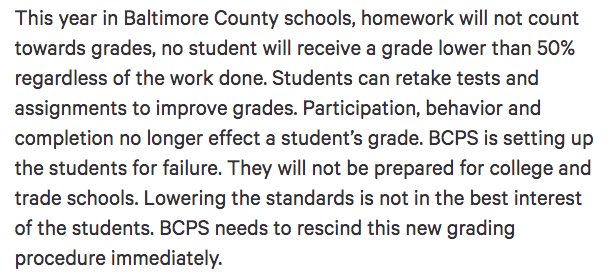After getting feedback from many parents, Baltimore County Public Schools is amending its grading policy. The new policy went into effect at the beginning of the year and said that homework and behavior in class would no longer count toward students’ grades.
A petition on change.org demanding that BCPS rescind its grading policy garnered more than 1,500 signatures.

Petition on change.org
“While thoughtful, progressive 21st century education is moving away from ‘studying for the test’ and taking a more holistic approach to a student’s overall achievement, BCPS’s new grading policy has moved backwards by making students care only about the test,” Abe Novick, a parent of two students at Towson High, told the Flyer. “As a result, many A students are now becoming C students due to narrow grading limitations where homework doesn’t count toward a student’s marking period grade. Eliminating a grade for homework is no way to encourage children to learn.”
An addendum to the new policy was released on Tuesday. No BCPS officials were immediately available to explain the changes in detail, but the the addendum says:
The Grading and Reporting Steering Committee reviewed stakeholder feedback. As a result, an addendum including three enhancements will be included in the Grading and Reporting Procedures Manual beginning second quarter.
1. Beginning at the high school level, in core courses tied to graduation requirements, the Department of Academics will provide more examples of assignments to be included in the body of evidence with suggested point ranges to model appropriate proportionality of assignment types.
2. At all levels, in all courses, the following parameters have been set around a marking period body of evidence to ensure appropriate proportionality of assignment types being factored into the marking period grade.
Gradebooks need to include non-graded, formative assignments and a body of evidence that includes both graded major and minor summative assignments. A body of evidence should not be made up of only traditional tests or assessments.
In a learning cycle, there is instruction (acquisition of knowledge and skills), practice (refining, developing, and clarifying knowledge and skills), feedback, and then an application/evaluation of student learning.
Formative assignments should be included in the non-graded portion during the instruction, practice, and feedback parts of the learning cycle. This could include homework assignments and classwork assignments given as practice.
Major summative assignments should apply/evaluate learning at the conclusion of the learning cycle. This can include projects, extended labs, culminating performances, research reports, unit tests, culminating events, PBAs (Performance-Based Assessments), and extended essays.
Minor summative assignments should apply/evaluate learning at the conclusion of the learning cycle (which could be in one day, or over multiple days). This can include daily classwork; homework assigned after instruction, practice, and feedback; discussions; learning checks; brief constructed responses; and exit tickets.
 A score on any one assignment cannot drop an overall marking grade more than one letter grade.
A score on any one assignment cannot drop an overall marking grade more than one letter grade.
3. Schools will provide consistency with regard to multiple opportunities for learning. Working with teachers through either the School Progress Team or the Instructional Leadership Team, parameters for multiple opportunities (re-dos) will be established, and clearly articulated to students and families.
-Secondary schools should establish consistent schoolwide parameters, including, but not limited to number of multiple opportunities, number of attempts, or length of time to submit.
-Elementary schools should establish consistent schoolwide parameters for grades 1-2 and grades 3- 5.
Cheri Pegues, the president of the Towson High PTSA, attended a meeting Tuesday evening in which BCPS community superintendents announced the revised policy and received feedback from parent leaders.
“I think it was an excellent meeting. The PTA presidents felt heard (although they only allowed 30 minutes for feedback) and it was made clear that there were problems with the implementation and understanding of the policy,” Pegues said. “The Community Superintendents stated that they do not want any student to suffer under this new policy. They had been holding meetings for much of the quarter to get feedback from parents and students. There just wasn’t any communication about that, which is unfortunate.”
Pegues went through more than 40 emails from concerned parents prior to the meeting and shared the following findings:
Increased anxiety and discouragement and decreased confidence and self-esteem when greater emphasis is placed on test scores: Not all students test well. There must be another way to show mastery of subject matter besides tests. Parents and students alike do not favor a test-heavy grade. They would like classwork and homework to count toward the final grade. For those students who do not test well, homework, classwork, and participation grades have been able to raise the overall grade. They also feel it is unfair that those students who do not complete homework are not penalized. The recurrent theme here was about motivated learners who do not test well and how their anxiety, frustration, and depression have increased during this first quarter with so much uncertainty.
Inconsistency in implementation of new grading policy: Teachers, parents, and students are confused. Some teachers seem to be uncertain of how to implement the new policy; either they don’t fully understand it or haven’t embraced it as an opportunity to rethink the way they conduct class and prepare students. Many parents shared that each teacher seemed to have their own set of rules regarding “re-doing” test. I think it’s a learning curve and perhaps not enough training had been given.
This new grading policy is affecting high school students in ways that could negatively impact their college and career options: Students’ grades have fallen drastically. Many parents shared that their former A students were now getting Cs. They feel that there are fewer grades, so fewer opportunities to raise an overall grade. Many parents feel it was very unfair to change the grading policy just as their children were getting to their junior or senior year.
Pegues said she was also encouraged by the willingness of Towson High’s principal, Charlene DiMino, to collect parents’ feedback.
“I am extremely grateful that Principal DiMino offered open communication and collaboration with the PTSA, parents, and students on this important issue,” Pegues said.


Quality points are changing next year for BCPS.
http://bsun.md/1hHO8A2
Would be good to compare the proposed changes to where other counties in Maryland are.
Yes, this has to do with weighted grades for GT/AA or other courses, with harder classes counting slightly more on transcripts. The BCPS policy says it would start in 6th grade in Fall 2016.. I wonder how that would affect middle school grading overall…
Here is a quote from the 2016 grading policy (p.42) “Beginning with students entering grade 6 for the first time in the fall of 2016, the same process to calculate GPA will be used to calculate QPA using the points assigned below . . . AP = 5, GT = 5, H = 4.5 ST = 4” (with AP, GT, H for Honors. ST is not defined, maybe ‘standard’ courses?)
Anyone know more details on this?
Yes, ST stands for standard.
Currently, an “A” is worth:
6 quality points in an AP/GT course
5 quality points in an honors course
4 quality points in a standard course